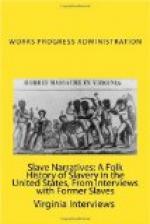Dr. Buckner remembers that when a young daughter of his master married, his sister was given to her for a bridal gift and went away from her own mother to live in the young mistress’ new home. “It always filled us with sorrow when we were separated either by circumstances of marriage or death. Although we were not properly housed, properly nourished nor properly clothed we loved each other and loved our cabin homes and were unhappy when compelled to part.”
“There are many beautiful spots near the Green River and our home was situated near Greensburgh, the county seat of Dreen [TR: Green?] County.” The area occupied by Mr. Buckner and his relatives is located near the river and the meanderings of the stream almost formed a peninsula covered with rich soil. Buckner’s hill relieved the landscape and clear springs bubled through crevices affording much water for household use and near those springs white and negro children met to enjoy themselves.
“Forty years after I left Greensburg I went back to visit the springs and try to meet my old friends. The friends had passed away, only a few merchants and salespeople remembered my ancestors.”
A story told by Dr. Buckner relates an evening at the beginning of the Civil War. “I had heard my parents talk of the war but it did not seem real to me until one night when mother came to the pallet where we slept and called to us to ‘Get up and tell our uncles good-bye.’ Then four startled little children arose. Mother was standing in the room with a candle or a sort of torch made from grease drippings and old pieces of cloth, (these rude candles were in common use and afforded but poor light) and there stood her four brothers, Jacob, John, Bill, and Isaac all with the light of adventure shining upon their mulatto countenances. They were starting away to fight for their liberties and we were greatly impressed.”




